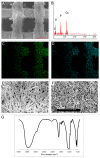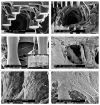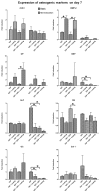Combining technologies to create bioactive hybrid scaffolds for bone tissue engineering
- PMID: 23507924
- PMCID: PMC3749798
- DOI: 10.4161/biom.23705
Combining technologies to create bioactive hybrid scaffolds for bone tissue engineering
Abstract
Combining technologies to engineer scaffolds that can offer physical and chemical cues to cells is an attractive approach in tissue engineering and regenerative medicine. In this study, we have fabricated polymer-ceramic hybrid scaffolds for bone regeneration by combining rapid prototyping (RP), electrospinning (ESP) and a biomimetic coating method in order to provide mechanical support and a physico-chemical environment mimicking both the organic and inorganic phases of bone extracellular matrix (ECM). Poly(ethylene oxide terephthalate)-poly(buthylene terephthalate) (PEOT/PBT) block copolymer was used to produce three dimensional scaffolds by combining 3D fiber (3DF) deposition, and ESP, and these constructs were then coated with a Ca-P layer in a simulated physiological solution. Scaffold morphology and composition were studied using scanning electron microscopy (SEM) coupled to energy dispersive X-ray analyzer (EDX) and Fourier Tranform Infrared Spectroscopy (FTIR). Bone marrow derived human mesenchymal stromal cells (hMSCs) were cultured on coated and uncoated 3DF and 3DF + ESP scaffolds for up to 21 d in basic and mineralization medium and cell attachment, proliferation, and expression of genes related to osteogenesis were assessed. Cells attached, proliferated and secreted ECM on all the scaffolds. There were no significant differences in metabolic activity among the different groups on days 7 and 21. Coated 3DF scaffolds showed a significantly higher DNA amount in basic medium at 21 d compared with the coated 3DF + ESP scaffolds, whereas in mineralization medium, the presence of coating in 3DF+ESP scaffolds led to a significant decrease in the amount of DNA. An effect of combining different scaffolding technologies and material types on expression of a number of osteogenic markers (cbfa1, BMP-2, OP, OC and ON) was observed, suggesting the potential use of this approach in bone tissue engineering.
Keywords: biomimetic coating; bone tissue engineering; calcium-phosphate; electrospinning; polymer; rapid prototyping.
Figures








Similar articles
-
Monolithic and assembled polymer-ceramic composites for bone regeneration.Acta Biomater. 2013 Mar;9(3):5708-17. doi: 10.1016/j.actbio.2012.10.044. Epub 2012 Nov 7. Acta Biomater. 2013. PMID: 23142480
-
Nano-ceramic composite scaffolds for bioreactor-based bone engineering.Clin Orthop Relat Res. 2013 Aug;471(8):2422-33. doi: 10.1007/s11999-013-2859-0. Clin Orthop Relat Res. 2013. PMID: 23436161 Free PMC article.
-
Osteogenic Differentiation of Mesenchymal Stem Cells with Silica-Coated Gold Nanoparticles for Bone Tissue Engineering.Int J Mol Sci. 2019 Oct 16;20(20):5135. doi: 10.3390/ijms20205135. Int J Mol Sci. 2019. PMID: 31623264 Free PMC article.
-
The Synergetic Effect of 3D Printing and Electrospinning Techniques in the Fabrication of Bone Scaffolds.Ann Biomed Eng. 2024 Jun;52(6):1518-1533. doi: 10.1007/s10439-024-03500-5. Epub 2024 Mar 26. Ann Biomed Eng. 2024. PMID: 38530536 Review.
-
Emerging Technologies to Enhance Osteogenic Differentiation of Bone Marrow Mesenchymal Stem Cells: Focus on Nanomaterials and Bioactive Compounds.ACS Biomater Sci Eng. 2025 Jun 9;11(6):3099-3113. doi: 10.1021/acsbiomaterials.4c01409. Epub 2025 May 7. ACS Biomater Sci Eng. 2025. PMID: 40332241 Review.
Cited by
-
Polycaprolactone-Based 3D-Printed Scaffolds as Potential Implant Materials for Tendon-Defect Repair.J Funct Biomater. 2022 Sep 23;13(4):160. doi: 10.3390/jfb13040160. J Funct Biomater. 2022. PMID: 36278629 Free PMC article.
-
Biomimetic Hybrid Systems for Tissue Engineering.Biomimetics (Basel). 2020 Oct 9;5(4):49. doi: 10.3390/biomimetics5040049. Biomimetics (Basel). 2020. PMID: 33050136 Free PMC article. Review.
-
Open-source three-dimensional printing of biodegradable polymer scaffolds for tissue engineering.J Biomed Mater Res A. 2014 Dec;102(12):4326-35. doi: 10.1002/jbm.a.35108. J Biomed Mater Res A. 2014. PMID: 25493313 Free PMC article.
-
Comparison of osteogenic differentiation potential of induced pluripotent stem cells and buccal fat pad stem cells on 3D-printed HA/β-TCP collagen-coated scaffolds.Cell Tissue Res. 2021 May;384(2):403-421. doi: 10.1007/s00441-020-03374-8. Epub 2021 Jan 12. Cell Tissue Res. 2021. PMID: 33433691
-
Integrational Technologies for the Development of Three-Dimensional Scaffolds as Platforms in Cartilage Tissue Engineering.ACS Omega. 2020 May 27;5(22):12623-12636. doi: 10.1021/acsomega.9b04022. eCollection 2020 Jun 9. ACS Omega. 2020. PMID: 32548446 Free PMC article.
References
-
- Hutmacher DW, Schantz T, Zein I, Ng KW, Teoh SH, Tan KC. Mechanical properties and cell cultural response of polycaprolactone scaffolds designed and fabricated via fused deposition modeling. J Biomed Mater Res. 2001;55:203–16. doi: 10.1002/1097-4636(200105)55:2<203::AID-JBM1007>3.0.CO;2-7. - DOI - PubMed
MeSH terms
Substances
LinkOut - more resources
Full Text Sources
Other Literature Sources
Miscellaneous
